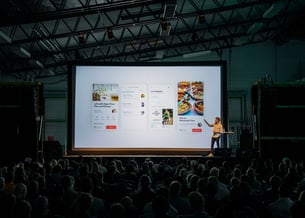
Why is Conference WiFi So Tricky to Pull Off? | WiFi SPARK
Conference attendees expect to be able to connect to a free guest WiFi network when they first arrive - it’s probably the first thing they’ll do when they are...
Read more
4 minute read | 27/11/2018

Embracing digital transportation can be difficult for some, but the benefits for Train Operating Companies (TOCs) are clear. If you’re struggling to implement cutting-edge systems, here’s how to get your team on board.
Before we go any further, it’s worth outlining exactly what digital transportation is. Digital transportation innovations aim to provide a seamless end to end journey experience, using technology to improve services for rail customers and increase revenue.
With passenger satisfaction low in the UK at the moment when it comes to the rail sector, it’s important we look for exciting new initiatives that can improve passenger satisfaction and experiences.
For TOCs, a key innovation that’s improved services in recent years was the introduction of station and onboard WiFi. It took a little while for the service to be fully embraced, but once it had it’s been successful, the results speak for themselves. As outlined in the NPRS, the availability of WiFi had a direct correlation to passenger satisfaction levels.
The rail sector has already seen digitalisation take place as processes transition from traditional to modern. We now buy tickets via phone apps and check on our trains via digital information displays. If the industry was a little more eager to implement digital initiatives, then we could see developments introduced faster.
There are countless other opportunities for digital technologies to be introduced to improve services. Renewable energy initiatives, sensor technology and data analytics are all on the cusp of being implemented. However, it can be difficult for the industry to change, especially when those in charge are unconvinced.
You might already have WiFi rolled out in your stations and onboard your trains, but you might not be using it to its full potential. The industry as a whole tends to allow the WiFi service providers to collect and keep the valuable data that’s collected from users when they use the WiFi. If TOCs want access to this data, some WiFi providers charge a fee.
It’s easy to understand why this has become common practice for TOCs who may not be equipped to deal with large volumes of raw data. They might not have the capability of translating the data into key takeaways that can be used to improve services.
Don’t settle for this. You shouldn’t be expected to pay for a fully-managed service, without also receiving valuable insights into passenger behaviour. The data can be used to understand where passengers spend most of their time and what routes they take and how frequently they travel.
TOCs can then adapt their services and offerings to see how passengers react. For example, if the data highlights that passengers who regularly take a certain route spend a lot of time on a particular platform, you can make changes so that concessions are promoted there. This is just one example of valuable data being used to increase sales and improve passenger satisfaction.
It’s important you choose a provider that lets you have access to your own data and insights and more importantly, has a digital platform that can display this in meaningful graphics with export or CRM integration options.
Onboard and station WiFi needs to do more than just offer connectivity. Passengers have come to expect WiFi in their day-to-day lives and are looking for more. One consideration is an entertainment library that could be accessed by passengers, which is something that some providers offer.
Once they’ve created an account, passengers would be able to enjoy television shows, films, newspapers, magazines and video games from the comfort of their seat without paying a penny more. You’d be providing them with a free entertainment system which would help to alleviate boredom, perfect if you’re travelling with kids.
Other clever passenger WiFi initiatives include loyalty database integration, meaning if your passengers already have a loyalty account with you , they can use that to log in to the WiFi service. This would give them a continuous session for a set period, with no need for them to re-register every time they travel with you.
As mentioned previously, the analytics can provide valuable insights that can enhance your marketing strategies. You can gather data through the WiFi that you would previously of had no idea about, making a real difference to your campaign results.
It isn’t easy to convince your team that change is necessary. There’s always going to be roadblocks and concerns from management that you could be making a mistake. To get them on the same page as you, frame your suggestion to match the goals of the organisation.
For example, if a key goal your TOC is working towards is increased revenue, highlight exactly how a switch of WiFi provider can achieve this. The innovations that we use and enjoy each day were once approached with the same scepticism and concern as the ideas that you might be trying to implement.
Teams are more likely to be on board with any transitions if they understand the long-term benefits, like the collation of analytics. The data that is collected can be utilised by both the marketing and customer experience teams to improve services moving forwards.
If the customer experience team has actual physical data of passengers’ key grievances, then they can make targeted adjustments in the future to try to fix the problem.
Getting your team on board with digital innovations isn’t easy but the results speak for themselves. You might face a little resistance at first but in the long run, you’ll see an improvement in the services you offer and passenger satisfaction.
We’ve put together a comprehensive eBook that details exactly how the WiFi can be utilised to maximise a TOC's brand, schemes and events. For your free copy of the eBook, click on the download link below.
Rebecca is the Marketing Director. She's worked for SPARK TSL since 2012. She is responsible for high level marketing strategy focusing on lead generation and aiding the vision of the business; to ensure that no patient has to pay for entertainment.
More articles by the author

Conference attendees expect to be able to connect to a free guest WiFi network when they first arrive - it’s probably the first thing they’ll do when they are...
Read more

The city you live in gets smarter each and every day. New technologies are shaping the way that decisions are made which impacts everything from the transport...
Read more

Online retailers track all kinds of analytics that tell them exactly how many people visit their websites and which of them leave without making a purchase....
Read more